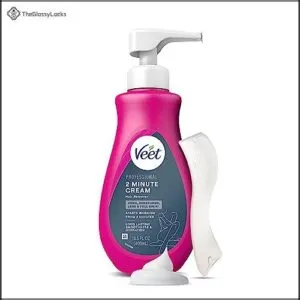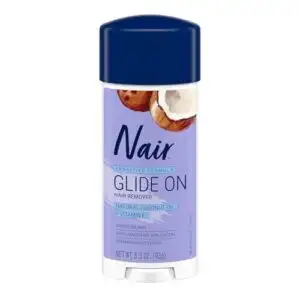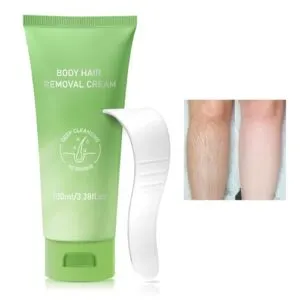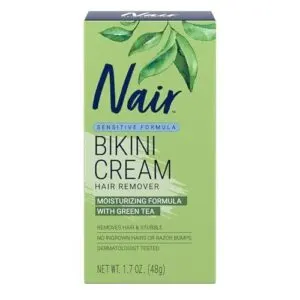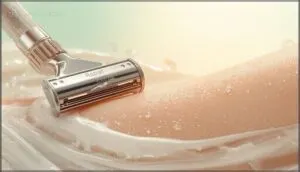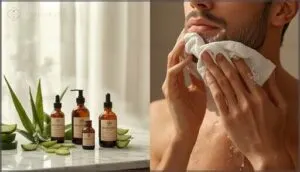This site is supported by our readers. We may earn a commission, at no cost to you, if you purchase through links.
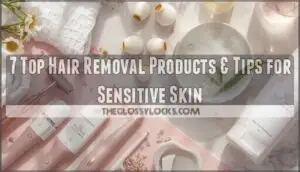
Your skin flares up at the slightest touch, turning what should be a simple grooming routine into a minefield of redness, bumps, and burning sensations. If you’ve ever abandoned a hair removal method halfway through because your skin staged a full rebellion, you’re not alone—dermatologists estimate that nearly 60% of people experience some form of irritation from standard hair removal techniques.
The problem isn’t you; it’s that most products and methods weren’t designed with reactive skin in mind. Fortunately, hair removal for sensitive skin has evolved beyond the one-size-fits-all approach, offering gentler alternatives that won’t leave you looking like you’ve had an allergic reaction.
From hypoallergenic creams to precision techniques that minimize contact, the right combination of products and practices can help you achieve smooth skin without the aftermath.
Table Of Contents
- Key Takeaways
- Best Hair Removal Methods for Sensitive Skin
- Choosing Gentle Hair Removal Products
- Top 7 Hair Removal Creams for Sensitive Skin
- Safe Shaving Tips for Sensitive Skin
- Waxing and Sugaring Without Irritation
- At-Home Hair Removal for Sensitive Skin
- Preventing and Managing Skin Irritation
- Long-Term Hair Removal Options
- Post-Hair Removal Skin Care Essentials
- Frequently Asked Questions (FAQs)
- Conclusion
Key Takeaways
- Nearly 60% of people experience irritation from standard hair removal methods, but choosing hypoallergenic products and techniques designed for reactive skin—like hard wax, sugaring, or single-blade razors—can reduce inflammation by 20-35% while delivering smooth results.
- Always patch-test new products 24 hours before full application and avoid exceeding recommended timing (typically 5-10 minutes for creams), since proper technique matters more than product choice when preventing chemical burns, redness, or folliculitis.
- Long-term solutions like laser hair removal (Nd:YAG or diode lasers with cooling systems) and IPL treatments achieve 75-90% hair reduction after six to eight sessions with minimal irritation, making them cost-effective alternatives to constant maintenance methods.
- Post-removal care is non-negotiable: rinse with cool water immediately after treatment, apply fragrance-free moisturizers with aloe vera or ceramides within hours, and watch for warning signs like persistent redness beyond 48 hours or yellow discharge that require dermatologist evaluation.
Best Hair Removal Methods for Sensitive Skin
Finding the right hair removal method when you have sensitive skin can feel like traversing a minefield, but you don’t have to settle for irritation or discomfort.
The good news is that several techniques work beautifully for reactive skin when you understand the pros and cons of each approach.
Let’s walk through the most effective options so you can choose what fits your skin’s needs and your lifestyle.
Shaving Techniques for Sensitive Skin
Before you shave, wet your skin with warm water for at least three minutes to soften hair and open pores. Choose single-blade or safety razors with fresh, hypoallergenic blades—dull razors tug and irritate. Always shave in the direction of hair growth using light strokes, and skip daily shaving if possible.
Afterward, rinse with cold water and apply fragrance-free moisturizer to calm inflammation. To minimize irritation, consider adopting a sensitive skin care routine.
Waxing and Sugaring Options
Waxing for sensitive skin works best with hard wax, which grips hair, not skin, cutting irritation by up to 35%. Sugar paste offers even gentler removal since it pulls in the direction of growth and contains only natural ingredients like sugar, lemon, and water. Both methods provide gentle exfoliation and longer-lasting smoothness.
A salon visit can help achieve optimal waxing results for those with sensitive skin. Look for hypoallergenic formulas with aloe or chamomile, and always patch test 24 hours before your first application.
Threading and Plucking Considerations
Threading hair removal uses tightly-woven cotton thread to lift hair from the follicle, reducing skin roughness by about 27% after three sessions while causing minimal irritation. You’ll feel brief stinging, but it’s gentler than waxing since there’s no heat or chemicals involved.
Plucking works similarly but triggers mild inflammation around individual follicles.
Both methods allow regrowth around 12 days later, so plan your maintenance accordingly.
Laser and IPL Treatments
For longer-lasting results, laser hair removal and IPL treatments target hair at the follicle, reducing growth by 85–90% after six to eight sessions. Nd:YAG and diode lasers work best for sensitive skin, featuring built-in cooling systems that minimize irritation.
While 10–15% of patients experience temporary redness, proper treatment customization and avoiding sun exposure greatly reduce pigmentation risks, making these methods increasingly viable for your delicate skin.
Depilatory Creams and Alternatives
Depilatory creams dissolve hair at the surface using alkaline compounds like potassium thioglycolate, generally working within 5–10 minutes. However, about 15–20% of you with sensitive skin may experience irritation.
- Always patch test 24 hours before full application
- Choose fragrance-free formulas enriched with aloe or vitamin E
- Never exceed recommended time to prevent chemical burns
- Consider natural alternatives like sugaring for gentler results
Choosing Gentle Hair Removal Products
When your skin reacts to everything, the wrong hair removal product can turn a quick routine into days of redness and regret. The good news is that gentle formulas do exist, and knowing what to look for makes all the difference.
Let’s break down how to spot truly skin-friendly products, which ingredients work in your favor, and what to steer clear of completely.
Identifying Hypoallergenic Formulas
Hypoallergenic labels on hair removal products don’t guarantee allergen-free formulas, but they signal reduced irritant risk for your sensitive skin. When you’re shopping, look beyond marketing claims and check for dermatologist-tested certifications. Patch testing remains your best safeguard since individual reactions vary, even with gentle formulas. Here’s what hypoallergenic generally means:
| Hypoallergenic Feature | What It Excludes | What to Verify |
|---|---|---|
| Fragrance-free formulas | Synthetic fragrances, parfum | Ingredient list transparency |
| Preservative-conscious | MI, MCI, formaldehyde releasers | Certification standards |
| Sulfate-free options | Sodium lauryl sulfate (SLS) | Clinical testing documentation |
| Paraben-free products | Parabens, harsh preservatives | Dermatological approval status |
| Natural ingredient focus | Harsh chemical depilatories | Allergen disclosure practices |
Key Ingredients to Look For
When selecting hair removal cream ingredients for sensitive skin, prioritize formulas with soothing ingredients like aloe vera and chamomile extract.
Look for moisturizing agents such as sweet almond oil, panthenol, and vitamin E, which offer antioxidant benefits while protecting your skin barrier.
pH buffers like calcium hydroxide keep formulations gentle, and barrier enhancers including cetearyl alcohol help lock in hydration throughout the process.
Ingredients to Avoid for Sensitive Skin
Your skin deserves better than formulas loaded with harsh chemicals that strip away its natural defenses. Avoid fragrance sensitivities by steering clear of perfumed products, which trigger reactions in susceptible individuals.
Watch for preservatives like methylisothiazolinone and formaldehyde-releasing compounds that cause contact dermatitis.
Skip exfoliating agents such as retinoids and AHAs before hair removal, and avoid dyes, colorants, and irritating cooling agents in sensitive skin care ingredients.
Top 7 Hair Removal Creams for Sensitive Skin
Finding the right hair removal cream can feel like searching for a needle in a haystack when your skin reacts to everything. You need products that remove hair effectively without leaving you red, bumpy, or uncomfortable.
Here are seven creams specifically formulated to work with sensitive skin, each with unique features worth considering.
1. Veet Professional Hair Removal Cream Bikini
When you’re dealing with sensitive skin, Veet Professional Hair Removal Cream Bikini offers a dermatologically tested formula that works in just 2 minutes. This hair removal cream blends shea butter with moisturizers, giving you 48 hours of smoothness while keeping irritation at bay.
The application technique is straightforward—use the included spatula to spread and remove the cream evenly. Clinical testing confirms it addresses coarse bikini hair effectively, though some sensitivity reports mention burning in crease areas if you don’t rinse thoroughly. Always patch-test before full use.
Best For: People with sensitive skin looking for a quick, gentle alternative to shaving or waxing in the bikini area, especially those who want smooth results without the hassle of razors or salon visits.
- Works fast—removes hair in just 2 minutes and keeps skin smooth for up to 48 hours.
- Gentle formula with shea butter and moisturizers that’s dermatologically tested for sensitive skin.
- Comes with a spatula for easy, mess-free application and removal.
- Might not fully remove coarse or stubborn hair in one go, sometimes needing a quick razor touch-up.
- Can cause irritation, redness, or burning in skin creases if not rinsed properly or left on too long.
- Has a strong chemical smell that some users find unpleasant, even though it’s milder than other hair removal creams.
2. Nair Sensitive Glide On Hair Remover
Nair Sensitive Formula stands out with its glide-on application that lets you target bikini lines, arms, and underarms without rubbing. The dye-free formula harnesses coconut oil benefits and vitamin E to moisturize while calcium thioglycolate does the work in 6 to 10 minutes.
User feedback confirms it’s a paraben-free safety win for sensitive skin, though you’ll want to patch-test first—some report burning if left too long.
Clinical studies back its dermatologist-tested claim, making it a reliable choice among hair removal creams when you follow timing instructions carefully.
Best For: People with sensitive skin who want a pain-free, mess-free way to remove hair from bikini areas, underarms, and arms without the hassle of shaving or waxing.
- Glide-on applicator makes it easy to apply evenly on hard-to-reach areas without rubbing or getting your hands messy.
- Gentle formula with coconut oil and vitamin E moisturizes while removing hair, and it’s free of parabens and dyes that can irritate sensitive skin.
- Works in just 6 to 10 minutes and keeps skin smooth for up to 6 days, saving you time compared to daily shaving.
- Strong chemical smell that some users find unpleasant, even though the formula is gentler than regular hair removers.
- Can cause burning or irritation if you leave it on too long or skip the patch test, so you need to watch the clock carefully.
- Small 3.3 oz size means you might run out quickly if you’re treating larger areas or need multiple applications for thicker hair.
3. Hair Removal Cream For Sensitive Skin
Generic hair removal creams for sensitive skin generally blend aloe vera, vitamin E, and calcium thioglycolate to dissolve hair in 5 to 10 minutes with 88–91% effectiveness. These depilatory creams keep skin smooth for 3 to 5 days, longer than shaving alone.
Before you commit, patch testing remains non-negotiable—timing matters more than you’d think, since exceeding instructions can trigger redness or mild burns. Look for dermatologist-tested formulas that include moisturizers, and you’ll minimize irritation while enjoying portable, travel-friendly results that rival Nair Sensitive Formula’s performance.
Best For: Anyone with sensitive skin who wants a quick, painless alternative to shaving that keeps skin smooth for several days without the hassle of waxing.
- Dissolves hair in just 5 to 10 minutes with 88–91% effectiveness, saving you time compared to traditional methods.
- Formulated with aloe vera and vitamin E to soothe and moisturize sensitive skin during the process, reducing irritation.
- Results last 3 to 5 days, giving you noticeably longer smoothness than shaving alone.
- You must follow timing instructions carefully—leaving it on too long can cause redness or mild chemical burns.
- Patch testing is required every time to avoid unexpected reactions, adding an extra step before use.
- Hair regrowth appears within 3 to 5 days, so you’ll need to reapply more frequently than waxing or other longer-term solutions.
4. Nopunzel Hair Removal Cream Sensitive Skin
Nopunzel Hair Removal Cream targets sensitive skin with aloe vera, vitamin E, hyaluronic acid, and allantoin—ingredients that nourish while calcium thioglycolate dissolves hair in just 8 minutes. You’ll notice it works faster than many generic hair removal creams, yet customer feedback confirms minimal redness when you follow patch-test protocols.
The dermatologist-tested formula manages fine to moderate hair effectively, though coarse growth may require a second pass. For gentle depilation on delicate zones like your bikini line, this cream balances hair removal safety with skin nourishment better than harsher formulas.
Best For: Anyone with sensitive skin who wants quick, painless hair removal on delicate areas like the bikini line without the harshness of traditional depilatory creams.
- Works in just 8 minutes with nourishing ingredients like aloe vera, vitamin E, and hyaluronic acid that soothe while they remove hair
- Dermatologist-tested formula causes minimal redness and irritation when you follow the patch-test instructions
- Effective on fine to moderate hair across various body areas, offering a gentler alternative to waxing or shaving
- May struggle with coarse or thick hair, sometimes requiring a second application to get all the stubble
- Can still cause itching or irritation in some people if you don’t follow the timing instructions carefully
- At $16.99 for 120g, it’s pricier than drugstore options if you’re using it frequently or on large areas
5. Nair Bikini Green Tea Sensitive Cream
If you prefer hair removal cream options that go beyond aloe-based formulas, Nair Bikini Green Tea Sensitive Cream uses calcium thioglycolate and green tea benefits to break down hair in 6 to 10 minutes.
You’ll find the dermatologist-tested blend works well on your bikini area, underarms, and legs without the nicks typical of shaving.
User feedback review notes a strong scent profile that some find off-putting, yet irritation risk factors stay low when you patch-test and avoid exceeding the 10-minute window on sensitive skin.
Best For: People with sensitive skin who want quick, pain-free hair removal in delicate areas like the bikini line, underarms, and legs without dealing with razor bumps or ingrown hairs.
- Works fast—removes hair in 6 to 10 minutes with minimal effort and no pain compared to waxing or shaving
- Dermatologist-tested formula with green tea extract soothes sensitive skin and helps prevent irritation, nicks, and razor bumps
- Affordable at around $7-$8 per tube and widely available at pharmacies and online retailers
- Strong chemical smell that many users find unpleasant during application
- May not completely remove all hair types, especially very fine or thick hair, requiring touch-ups
- Can cause skin irritation or burns if left on too long or used without patch testing first
6. Painless Hair Removal Cream For Women
Beyond the green tea-infused depilatories, you’ll want to explore hair removal cream options that hit that 97.9% effectiveness mark without the sting. Painless hair removal cream for women generally relies on potassium thioglycolate paired with glycerin and urea to dissolve stubborn hair while keeping sensitive skin comfortable.
Market trends show these hair removal products gaining traction because they sidestep cuts and ingrown hairs. Before full application, sensitivity testing remains non-negotiable—patch-test 24 hours ahead, follow cream application tips for your specific body zone, then moisturize thoroughly for post-cream care that locks in smoothness.
Best For: Women with sensitive skin who want a quick, painless alternative to shaving that removes stubborn hair from legs, arms, underarms, and bikini areas without cuts or irritation.
- Delivers up to 97.9% hair removal effectiveness in 5-10 minutes with no nicks or razor burn
- Hypoallergenic formula with glycerin and urea keeps skin moisturized and comfortable during use
- Longer-lasting smoothness than shaving since it dissolves hair slightly below the skin surface
- Requires a 24-hour patch test before full application to avoid allergic reactions or chemical burns
- Cannot be used on face, head, or intimate genital areas due to safety concerns
- Around 10-15% of users may experience mild burning, stinging, or redness despite gentle formulation
7. Veet Hair Removal Cream Sensitive Skin
Veet Hair Removal Cream Sensitive Skin earns dermatological acceptance through its aloe vera and vitamin E formulation, paired with potassium thioglycolate that dissolves hair in 3–10 minutes. Cream specifications include a 200ml tube with spatula, formaldehyde-free composition, and moisturizing glycerin that hydrates skin up to 24 hours post-use.
Consumer feedback consistently highlights effective removal on legs, arms, and bikini areas without the redness typical of harsh depilatories. You’ll want to patch-test first and rinse thoroughly—hair removal cream ingredients work best when applied correctly.
Best For: People with sensitive skin looking for a quick, affordable alternative to shaving that delivers smoother results lasting up to twice as long.
- Works fast (3-10 minutes) and removes even very short hair close to the root without irritation for most users
- Enriched with aloe vera and vitamin E to leave skin soft and moisturized for up to 24 hours
- Dermatologist-tested formula is formaldehyde-free and comes with an easy-to-use spatula for mess-free application
- May cause tingling or irritation if left on too long, and requires a patch test before first use
- Has a noticeable chemical smell that some users find unpleasant
- Doesn’t always remove 100% of hair in one go and may become less effective with repeated use over time
Safe Shaving Tips for Sensitive Skin
Shaving doesn’t have to leave your sensitive skin red and irritated if you follow the right approach. The key is knowing how to prep your skin, choose your tools, and care for yourself afterward.
Here’s what you need to do before, during, and after each shave to keep irritation at bay.
Preparing Skin Before Shaving
Think of your skin as a canvas that needs priming before you work on it. Proper skin preparation makes all the difference when shaving sensitive skin. Here’s your essential pre-shave routine:
- Hydrate with warm water for at least three minutes to soften hair and open pores, reducing friction and irritation risks.
- Cleanse gently using a pH-balanced wash to remove debris without stripping your skin’s protective barrier.
- Exfoliate 12-24 hours before shaving to lift hairs and prevent ingrown bumps, then apply protective shaving products designed for sensitive skin.
Using Sharp Razors and Proper Tools
Your razor blade quality directly determines your shaving experience. Sharp blades cut hair cleanly without tugging, reducing razor burn and razor bumps on sensitive skin. Single-blade safety razors generally cause less irritation than multi-blade cartridges.
Replace blades every 5-7 shaves and clean them after each use. Dull blades force multiple passes and increased pressure, triggering inflammation and compromising your skin barrier through friction and irritation.
Shaving in The Direction of Hair Growth
Shaving against the grain might give you a closer shave, but it’s a fast track to razor burn and ingrown hairs on sensitive skin. Always shave in the direction your hair grows—this technique’s importance can’t be overstated for irritation reduction and ingrown prevention.
Studies show shaving with the grain cuts adverse reactions by up to 60%, protecting your skin barrier while still achieving smooth results. Map your hair growth patterns first, since direction varies across different body areas.
Shaving with the grain cuts reactions by 60% and protects your skin barrier, so map your hair growth patterns first since direction varies across body areas
Post-shave Skin Care Routines
Your shaving for sensitive skin routine doesn’t end when the razor does. Rinse with cool water to close pores and calm inflammation, then gently pat dry—never rub.
Apply alcohol-free balms or hydrating beard oils immediately to moisturize skin and lock in hydration.
Always conduct patch testing before using new skincare products to prevent skin irritation and adverse reactions.
Waxing and Sugaring Without Irritation
Waxing and sugaring can work beautifully for sensitive skin when you take the right steps to protect yourself. The key is choosing gentle products and using techniques that won’t leave your skin angry and inflamed.
Here’s what you need to know to get smooth results without the irritation.
Pre-waxing Skin Preparation
Your skin needs a little TLC before waxing to avoid unwanted reactions. Proper prep work reduces redness and keeps irritation at bay, especially for those dealing with skin sensitivity.
Here’s your pre-wax game plan:
- Gentle Cleansing: Use fragrance-free cleansers 24 hours before to remove bacteria without stripping your skin.
- Exfoliation Timing: Exfoliate 24-48 hours prior—not right before—to prevent ingrown hairs.
- Skin Hydration: Moisturize daily leading up to your appointment for better pliability.
- Irritant Avoidance: Skip retinoids, alcohol-based products, and sun exposure beforehand.
Always do a patch test if you’re trying new products—your skin will thank you.
Choosing Hypoallergenic Wax or Sugar
Once you’ve prepped your skin, the right wax makes all the difference. Hypoallergenic wax ingredients like tea tree oil and chamomile soothe while removing hair, reducing pain compared to traditional formulas.
Sugaring offers gentleness through its natural composition—it adheres only to dead cells, minimizing trauma.
Both methods slow hair regrowth over time, but sugar’s application ease at home gives it an edge for sensitive skin care.
Proper Waxing Techniques
Having chosen hypoallergenic wax, you’ll want to master the sectioning method. Apply wax at temperatures between 120°F and 140°F to prevent burns while ensuring effective hair removal for sensitive skin. Hard wax works best since it grips hair, not skin.
Consider these gentle hair removal techniques:
- Apply wax in small sections for better control
- Wait until it hardens before removal
- Pull against hair growth in one swift motion
Avoid repeated passes over the same area.
Soothing Skin After Waxing
Right after waxing, apply a cold compress to reduce redness and swelling—it constricts blood vessels fast. Follow with aloe vera or tea tree oil gels for inflammation control and skin calming.
Over 75% of women notice better comfort using soothing lotion after Brazilian wax treatments. Wear loose, breathable clothing to prevent friction, and skip hot baths for 24 hours to support proper waxing aftercare and minimize skin irritation.
At-Home Hair Removal for Sensitive Skin
At-home hair removal gives you the freedom to manage unwanted hair on your own schedule, without the hassle of salon appointments. If you have sensitive skin, you’ll want to choose methods that work gently and effectively while minimizing irritation.
Here’s what you need to know about the safest at-home options that won’t leave your skin red or uncomfortable.
Using Hair Removal Creams Safely
Hair removal creams offer convenience, but they come with a catch—chemical burns and irritation if you’re not careful. Your sensitive skin deserves a thoughtful approach to stay irritation-free.
- Patch testing 24 hours before full application helps you spot allergic reactions early and prevents unwelcome surprises.
- Limit application time to 10 minutes or less, as longer exposure increases irritation risk without improving results.
- Rinse thoroughly with cool water without rubbing to remove all chemical residue and minimize inflammation.
- Apply soothing moisturizer afterward with aloe vera or vitamin E to restore your skin’s barrier and calm any redness.
Watch for irritation symptoms like persistent burning, hives, or swelling—these signal it’s time to stop use and consult your dermatologist for safer alternatives.
Home Laser and IPL Devices
At-home laser and IPL hair removal devices offer a practical middle ground between professional treatments and traditional methods. Device effectiveness reaches 46-52% hair reduction after consistent use, especially on lighter skin with dark hair.
You’ll need 6-8 sessions over 2-3 months, and user satisfaction depends on following safety precautions like patch testing and adjusting intensity for your skin sensitivity.
DIY Sugaring and Waxing Kits
Convenience meets effectiveness when you explore at-home sugaring and waxing kits designed for sensitive skin. Sugaring removes hair from the root, delivering three to four weeks of smooth results while applying at room temperature to avoid burns.
Hypoallergenic wax formulas reduce redness by about 20%, and complete kits include pre- and post-wax sprays that greatly improve comfort for sensitive skin types.
Threading and Coil Removers for Facial Hair
Threading benefits your sensitive skin by removing facial hair without chemicals or heat, reducing roughness by up to 30% after just three sessions. Both gentle hair removal methods suit skin sensitivity issues, though threading offers more precision while coil removers work best for self-use on cheeks and upper lip.
Coil advantages include quick removal of multiple hair rows simultaneously, making them faster than tweezing while avoiding ingrown hairs common with waxing.
Preventing and Managing Skin Irritation
Even with the gentlest products and techniques, sensitive skin can still react to hair removal if you skip a few key steps. The good news is that most irritation is preventable when you know what your skin needs before, during, and after the process.
Let’s walk through the essential strategies that’ll help you avoid redness, bumps, and discomfort.
Exfoliation Before Hair Removal
Think of exfoliation as clearing the path before hair removal—it lifts away dead skin cells that trap hairs and cause those frustrating ingrown bumps.
You’ll want to exfoliate gently about 1-3 days before your chosen method, using soft scrubs or mild chemical exfoliants suited to your skin type. This timing balances ingrown prevention with inflammation risks, making your skincare for sensitive skin routine more effective.
Moisturizing Sensitive Skin
After hair removal, your skin craves hydration—moisturizing rebuilds the protective barrier that’s been compromised. Wait a few hours post-treatment before applying moisturizer gently—your skin will thank you.
Look for these Post-Treatment Care essentials:
- Hypoallergenic formulas with aloe vera and hyaluronic acid that deliver Clinical Evidence-backed hydration (up to 59% increase within hours)
- Fragrance-free options containing ceramides for barrier repair
- Lightweight gels that absorb quickly without clogging pores
- Vitamin E-enriched products that calm inflammation
Recognizing and Treating Adverse Reactions
Even with careful preparation, adverse reactions can catch you off guard—about 10–15% of people with sensitive skin experience pronounced issues after hair removal. Watch for skin redness, swelling around follicles, or hives signaling allergic reactions.
Treatment options include hydrocortisone cream, cold compresses, and oral antihistamines. Patch testing before full application remains your best preventative measure against unexpected skin irritation.
Long-Term Hair Removal Options
If you’re tired of constant maintenance and want results that actually last, long-term hair removal methods might be the solution you’ve been looking for. These improved treatments can greatly reduce or even eliminate hair growth over time, which is especially appealing when you’re dealing with sensitive skin that doesn’t respond well to frequent shaving or waxing.
Let’s explore the main options that deliver lasting results while keeping your skin happy and healthy.
Laser Hair Removal Benefits for Sensitive Skin
If you’re looking for hair removal methods for sensitive skin that deliver lasting results, laser hair removal benefits stand out. This technique offers reduced irritation by targeting follicles beneath the surface, sparing you from razor bumps and ingrown hairs.
You’ll see long-term reduction—around 75% after six months—along with improved texture and cost efficiency over time. Precision safety features protect delicate areas, giving you irritation-free skin without constant upkeep.
IPL Treatment Advantages
IPL hair removal offers gentle therapy that addresses multiple concerns—hair reduction, skin rejuvenation, and uneven tone—all at once. With minimal downtime and less discomfort than laser hair removal, it is ideal for sensitive skin hair removal.
After four months, you can expect around 75% hair reduction and irritation-free skin that feels softer. The benefits of IPL extend beyond simple removal to genuine improvement.
Electrolysis for Permanent Results
When you want true permanence, electrolysis stands out. This FDA-approved method uses a fine electric current to destroy individual hair follicles, achieving about 90-93% permanent hair removal success.
It works on all skin types and hair colors without harsh chemicals, making it particularly suitable for sensitive skin.
Expect multiple sessions over several months, with costs ranging from $50 to $180 per session depending on the treatment area.
Professional Vs. At-home Treatments
Professional hair removal treatments deliver over 90% hair reduction with specific laser settings tailored to your skin tone and sensitivity. In contrast, at-home hair removal methods often yield patchy, temporary results.
A cost comparison reveals that professional treatments require fewer sessions, despite their higher upfront expense.
Your dermatologist can enhance treatment outcomes and ensure skin safety through expert guidance, minimizing risks like burns or irritation that many at-home hair removal products cannot prevent alone.
Post-Hair Removal Skin Care Essentials
What you do after hair removal matters just as much as the method you choose, especially when your skin is prone to react. The right aftercare routine can make the difference between smooth, calm skin and days of redness or bumps.
Here’s what you need to know to keep your sensitive skin happy once the hair is gone.
Immediate Aftercare Steps
Right after hair removal, your skin needs gentle attention to minimize irritation and speed healing. Start with these cooling techniques for redness reduction and skin calming:
- Apply a cold compress wrapped in soft cloth for 10–15 minutes to reduce swelling without direct ice contact.
- Use aloe vera gel or soothing lotion designed for posttreatment skin care to promote comfort.
- Keep skin hydrated with fragrance-free moisturizer to support your skin’s protective barrier and prevent dryness.
Avoiding Harsh Chemicals and Fragrances
After hair removal, chemical irritants and artificial fragrances can trigger reactions in up to 25% of users with sensitive skin. Look for dyefree and parabenfree labels when choosing aftercare products. Patch testing new formulas 48 hours before full application reduces irritation risk by about 30%.
Natural alternatives with aloe vera or chamomile offer gentler options, helping you avoid fragrance allergies while supporting comfortable healing.
When to Consult a Dermatologist
When should a simple post-treatment reaction cross into medical territory? If you notice persistent redness beyond 48 hours, intense pain that won’t ease, or yellow discharge from the treated area, it’s time to see a dermatology specialist. Severe itching, recurring folliculitis, or unusual skin reactions warrant professional evaluation—especially if you have underlying skin conditions or skin allergies that complicate healing.
- Persistent swelling or warmth spreading from the removal site
- Signs of infection like red streaks or worsening skin irritation
- Pigmentation changes or scabs lasting over a week
Frequently Asked Questions (FAQs)
Can I remove hair during a skin flare-up?
Hold off during flare-ups—dermatologists stress timing readiness and flare-up contraindications.
Active eczema or psoriasis increases method impact on skin reactions, worsening sensitive skin conditions.
Expert recommendations favor waiting until inflammation clears completely.
How often should sensitive skin be exfoliated?
You should exfoliate sensitive skin once or twice weekly using gentle methods like enzymatic formulas or aloe vera-based products.
Over-exfoliation risks barrier damage and irritation—watch for symptom assessment cues, and seek professional advice if needed.
Are natural oils safe for post-removal care?
Natural oils can be safe if you dilute them properly and do a patch test first. Coconut oil, aloe vera, and similar natural ingredients offer oil benefits, but undiluted formulas risk allergic reactions and skin irritation.
What causes ingrown hairs on sensitive skin?
Your hair is like a compass needle—when it can’t find true north, it gets lost beneath the surface.
Curly hair structure, aggressive shaving techniques, and skin sensitivity create the perfect storm for ingrown hairs.
Should I test products before full application?
Yes, always patch test. Apply product to a small area for 24 hours to identify potential allergies before full use.
Dermatologist advice emphasizes testing frequency—even familiar formulas—since skin sensitivity changes over time.
Conclusion
Here’s the truth: hair removal for sensitive skin doesn’t have to be a gamble between smoothness and inflammation. You’ve now got the roadmap—hypoallergenic products, gentle techniques, and post-care essentials that actually work with your skin instead of against it.
The key lies in treating each session like a precision task, not a race. When you respect your skin’s boundaries and choose methods designed for reactivity, irritation becomes the exception, not the inevitable consequence.


